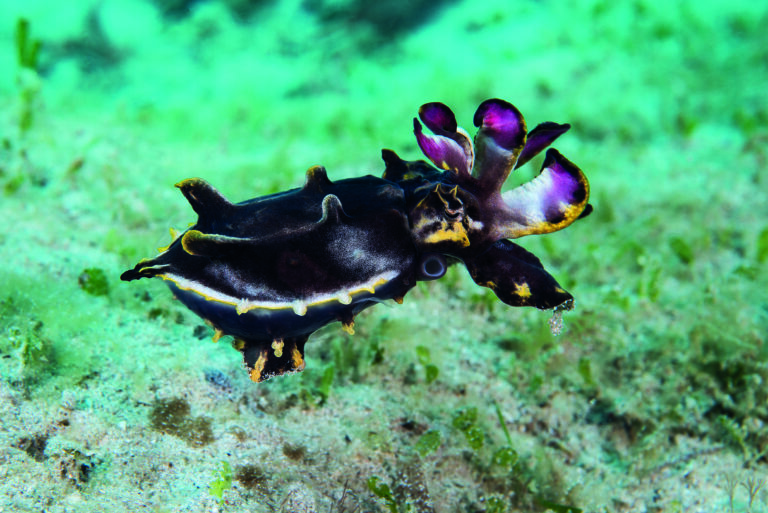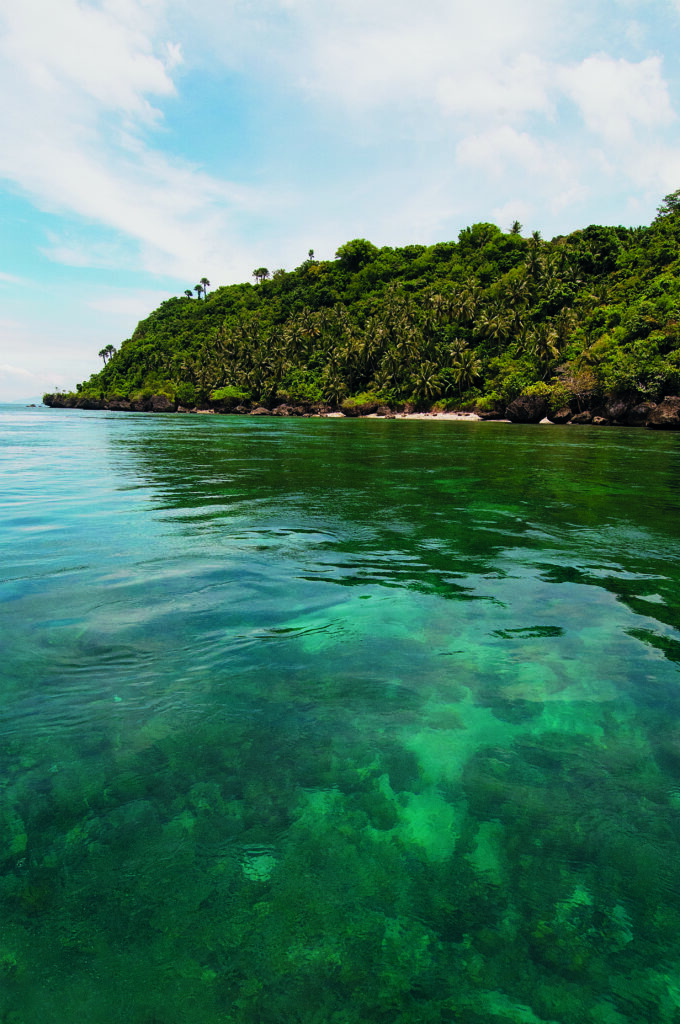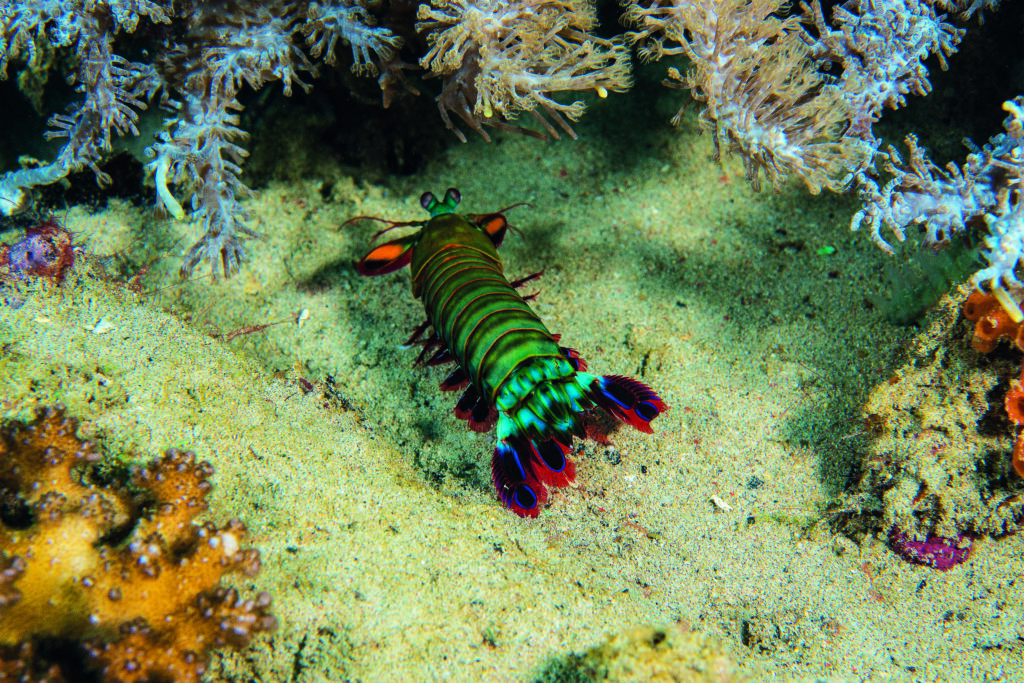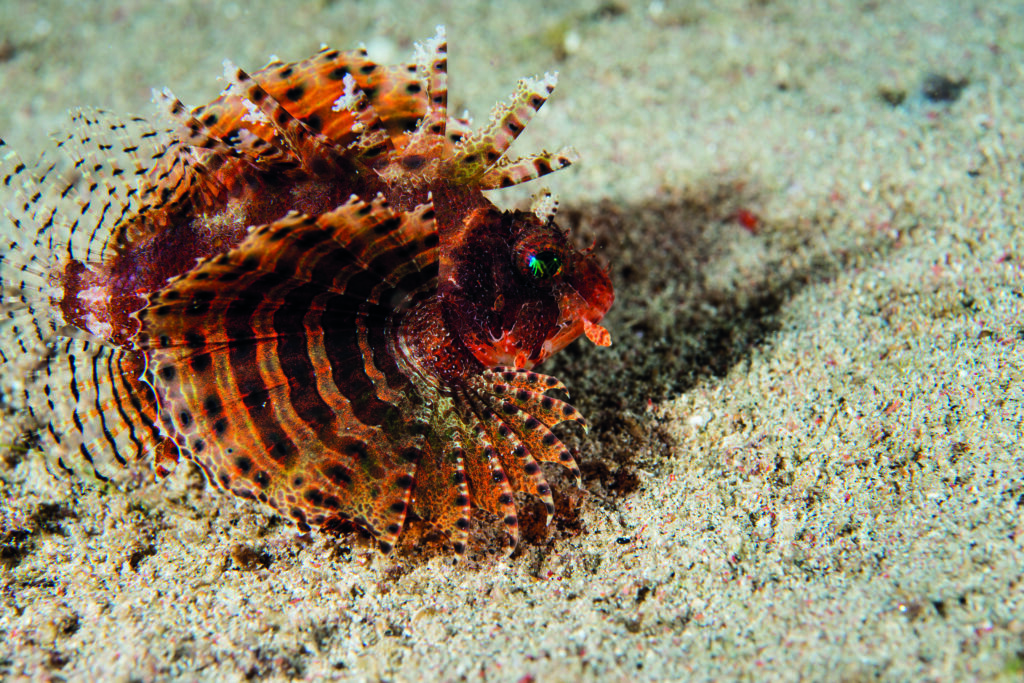AL HORNSBY has dived around the world but he reserves a special place in his heart for the rich biodiversity of this Philippines hotspot
We had dropped in on Fantasea Reef just moments before, following a two-minute (really) boat-ride from the resort’s beach. The shallow site was a sprawling, complex collection of hard and soft corals, intermittent sand patches, vibrant colours and loads of life.
We were on a mission. The afternoon before, we had found two pygmy seahorses (Hippocampus bargibanti) hidden in the branches of a massive red gorgonian, the male hugely pregnant (or as huge as a tiny seahorse can ever be).
Shooting with a 60mm micro lens I had images of the miniscule creatures, but they were just not as close-up as I might have liked. Today I had a 105mm macro, and was ready.
Determined shell-cleaner
We quickly found the place but, to our surprise, someone else had already laid claim to the spot. A gigantic green turtle was rubbing its lovely shell back and forth against the trunk and lower branches of the seafan, causing the branches to sway like a tree in a violent wind.
Respecting the turtle’s right to be there, we tried to find the seahorses without disturbing it. We soon located the head-of-a-pin-small male, but my attempts to focus the 105mm in the turtle-produced gale were both dizzying and hopeless.
I looked up at Rodil, my dive-guide, and gradually my bemused smile turned to chuckles, then broke into one of those mask-filling bouts of underwater laughter that only divers can truly appreciate.
We waited patiently for a while, until Rodil finally moved over to the turtle to gently push it away. It resisted, refusing to give up its prime rubbing-post, and this went on for a while until it finally relented – although it didn’t leave altogether, but kept coming back for another go.
I managed to slip into the spot where the seahorse was perched, tail wrapped around a small branch, and, with the turtle watching closely, began shooting.
Macro for a turtle
I remember thinking that a wide-angle lens would have captured an amazing series of images of the turtle in this situation but with a 105mm on I could manage only a very nice close-up of the turtle’s face and one of the nearly 1m-long yellow and green shark-suckers on its back. And, oh yeah, I got my pygmy seahorse, yes indeed.
As special as this particular dive was, in my four-and-a-half days doing four to five dives a day, from early mornings on into the nights, it was really just one of many special dives. In all my years of diving, I can honestly say that I have never before seen such a remarkable, multitudinous array of exotic marine life – especially unusual macro creatures – as I found around Puerto Galera.
Whether on coral reefs, in sandy-muck channels, on grass beds, around an ocean pinnacle off a neighbouring island or even on a nearby offshore wreck – the 30m-deep Alma Jane – every dive was a “creatures on parade” experience.
Given the location, in the heart of biodiversity for the world’s oceans, this shouldn’t have been a complete surprise, but the remarkable richness of the life there… still was. The night dives were, if anything, even more amazing, with something new and exotic seemingly every few moments.
The ease of the diving also made finding “more” simple to accomplish. With the boats just steps away from Atlantis Dive Resort’s gear lockers, and boat-rides generally a matter of a few minutes, doing so many dives a day was not a strain, and there was plenty of time between dives for a hot shower, a meal, coffee or tea, camera prep and so on.
And the sharp-eyed dive guides knew their home territory and its resident denizens very well indeed.
Out to Sabang
It’s difficult to choose a list of favourite sites but, like Fantasea Reef, a number of them stood out. One would be the location of my first dive on arrival (and a couple of my night dives) in an area just minutes straight out from the resort called Sabang (named for the town, Sabang Port and its bay).
Averaging 15m and less of depth, this was an area of shipwreck debris, sand and intermittent coral patches, with turtle-grass beds toward shore.
My first dive there was memorable. We quickly found an orange giant frogfish and, shortly thereafter, one of the creatures on my “hoped-for” shot-list peeked out of its lair beneath a small coral head – a large, brilliantly coloured peacock mantis shrimp.
It was shy at first, continually ducking back into its hole, but finally it emerged and moved quickly away. I followed slowly, giving it space, but keeping it in sight until it ducked into another hole.
As I approached, the bold mantis, apparently tired of being followed, suddenly came out, marched across the sand to me and stood up in challenge, allowing me a series of very close images. Just moments later, my guide, Aires, excitedly pointed toward a whitish, pebbled area on the seabed where I was able to see – nothing.
He kept pointing insistently – obviously at something very, very small. I looked more closely and finally saw an exquisite, less than pea-sized, white, juvenile blue-ringed octopus, who made a splendid image.
Night dives
In this same area on night dives, I also photographed – among many others – a lovely fingered dragonette, which went into full display as I approached, two pairs of sea moths, several peacock flounders, an intricately-patterned dwarf lionfish and a large, hairy hermit crab in a huge Triton’s trumpet shell.
The crab came marching out of the darkness across the sand bottom, coming right into our lights. A lovely Napoleon snake-eel, head sticking up out of its burrow, was another exotic creature I had never photographed before.
Another remarkable site was reached by a quick trip around the point from Sabang Bay. The sand beach turns to steep, jungled iron-shore, and Sinandigan was one of several great sites up against the coastline.
Under water, the shallows are a maze of crevices, swim-throughs and tumbled coral gardens in clear, still water. Beyond the colourful beauty of the hard and soft corals, whip corals (complete with whip-coral shrimp and gobies), swirling reef tropicals, patches of yellow sea cucumbers and many anemones with anemonefish, it is also a nudibranch treasure-trove.
Down the slope, the drop turns steep to become a wall with bigger fish, turtles and many overhangs – one home to a blue-spotted ray. Back in the shallows toward dive’s end, another shot-list image was captured when a bold banded krait interrupted its feeding to swim directly to my camera.
Verde Island
After several days of macro, we headed eastward on a 50-minute boat-ride to nearby mountainous Verde Island. Just offshore the top of a submerged pinnacle was visible, and it provided us with two remarkable dives along an area called the Drop-off.
On the first, we dropped to 30m on a brisk current along a steep, gorgonian, soft coral and barrel sponge-blanketed wall. Swirling fish surrounded us, including bands of spadefish and a large school of long-jawed mackerel.
In calm water around a corner we saw grouper, snapper, sweetlips and hordes of reef fish, plus several large, green turtles.
On our second dive, we stayed shallower and discovered a brightly coloured wall area completely covered with soft corals and sponges. It was home to many fish and several very calm banded kraits nosing about in the nooks and crannies.
Best till last
My most productive dive, however, was saved for my final outing before packing up the gear and heading home.
On the side of Puerto Galera away from Sabang Bay were several small islands that create a series of protected, sand-bottomed channels – the sites for muck-diving in its truest sense. One called the Hill consisted of a series of sandy slopes with a winding, 20m-deep channel meandering between them.
This particular afternoon, a large dive-group had just left the resort and a couple of the guides, having nothing on their dive-schedules, asked if they could go along with us.
What resulted was unique. The four of us, spaced about 10m apart in a long line, effectively covered nearly 40m of bottom. As we moved along, waggling lights and tank-banging from both sides had me constantly moving from discovery to discovery for a non-stop 75 minutes, even into a long safety-stop.
At the Hill, shooting hundreds of frames, I got images of several pairs of spiny waspfish, flamboyant cuttlefish and eggs, an unusual ocellated poison octopus that stood up in a defensive posture (they bite from underneath, of course) on tip-toes for a portrait.
There were three species of seahorse, a goldbar sand-diver, an unusual chiagra mantis, magnificus shrimp on tube anemones, a seldom-seen rubrolineata nudibranch, stumpy-spined and reaper cuttlefish, an unusual saddled snake-eel – the list went on, and on. Wow!
This dive-trip was one that takes its place as special, even after so many years of being fortunate enough to dive many of the world’s most celebrated locations.
And, as other individual divers and couples I met at the resort told me, the surrounding town of Sabang Port, a small, bustling, resort-beach village of winding streets lined with restaurants, bars and clubs, was a holiday treat in itself.
Me, I never made it out on the town – with every dive being so remarkable, I could not have been tempted to miss even one.
Atlantis Dive Resort Puerto Galera
For the resort and dive operation, a PADI 5* centre, the owners’ stated aim was to “create a great resort that makes sure guests don’t have to sacrifice anything in their search for the best diving“. They work to provide an all-inclusive offering centred on great service and diving, modern, comfortable rooms, wide-ranging activities (including a luxurious spa), delicious food and a friendly, well-trained staff.
The resort’s 40 rooms, which extend from near the beach up a hillside for wonderful views of Sabang Bay, have full facilities and amenities, including wi-fi.
Atlantis Dive Resorts operates in both Puerto Galera and Dumaguete and also operates the liveaboard vessel Atlantis Azores.
Photographs by Al Hornsby






